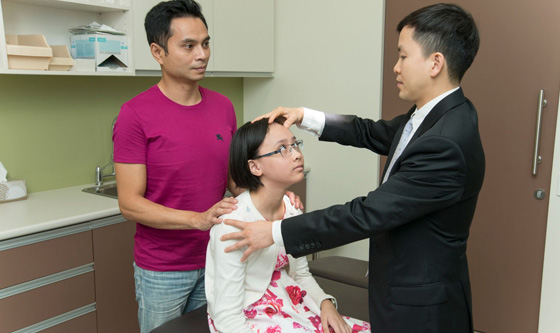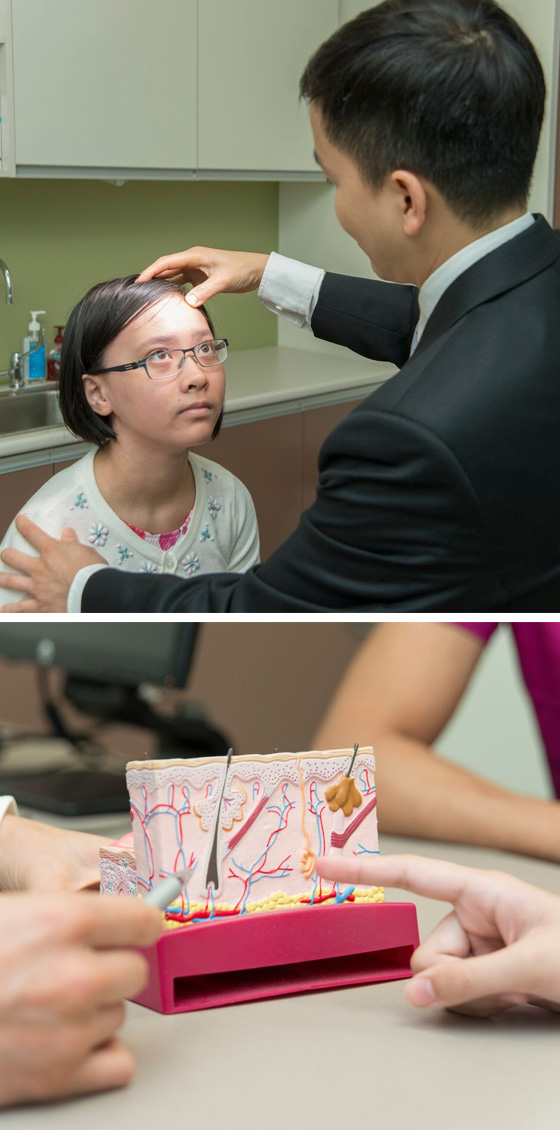Overview
Eczema or atopic dermatitis is a very common and increasingly more prevalent condition in the Western world. The cause of eczema is not precisely defined but is likely due to a complex interaction of genetic and environmental factors. Eczema affects children particularly and can have significant impact on their health due to itching, disrupted sleep and secondary infections. Severe eczema can cause growth delay and behavioural difficulties in the child as well as parental exhaustion and distress.
The management of eczema, like many chronic medical conditions, is complex. It usually requires a combination of topical treatment and alterations in lifestyle. Patients with more severe uncontrolled disease may also require oral systemic treatment or phototherapy. Having an Eczema Management Plan tailored to the child’s specific needs is critically important in the long term. Dermatologists at our clinic can work with you and your general practitioner to develop this plan.

What causes eczema?
Genetic predisposition to eczema has long been recognized. In 2006, mutations leading to loss of function in the filaggrin gene were identified and reported in about 50% patients with severe eczema. Defects in filaggrin gene cause impaired skin barrier function predisposing the individual to eczema. However, a number of environmental factors have been identified to play an important role in the causation and manifestations of eczema. The relative importance of each of these factors can vary depending on the person’s age and circumstances. The following factors may exacerbate eczema:
- Frequent use of soaps and detergents
- Cold and dry climate
- Obesity and fast food consumption
- Food allergy: common in young children with eczema. However, avoidance of the food allergens very rarely leads to complete resolution of eczema. The role of food allergy is much less relevant in children older than 6 years of age and in adults.
- Staphylococcus aureus infection: common and is associated with flares of eczema

How does eczema manifest?
The majority of patients develop eczema before 2 years of age with a characteristic itchy rash. It predominantly affects the face during infancy, elbows and knees as the child starts to crawl, then flexural skin (in front of elbows and behind knees) from walking age onwards. Eczema tends to improve as the child grows older with up to 60% of affected children being clear of eczema by adolescence. However, about a quarter of them will relapse during adulthood with usually more limited eczema. The hands and lips are commonly affected in adulthood.
General skincare for eczema
Avoidance or reduction of triggers and exacerbating factors
- Avoid irritants such as soaps and detergents
- Avoid clothing materials that can irritate such as wool or synthetics. Light cotton materials are recommended
- Avoid exposure to harsh environments such as cold dry winter wind or excessive heat and sweating
- Reduce airborne allergens such as house dust mites as well as grass and tree pollens
- Identify and avoid food allergens. However this must be supervised to ensure adequate nutrition
- Reduce psychological stress
- Treatment of infections such as S. aureus
Bathing and emollients
- Bathing with bath oils is recommended. Bathe as soon as possible if the skin is irritated by sweat, dust or airborne allergens
- Frequent and adequate use of emollients is critically important to help with the impaired skin barrier function in eczema.
Treatment for eczema
There is no permanent cure available for eczema at the present time. However, there are effective treatments for this condition such that it should cause minimal impact on quality of life. Treatment must be optimized to your own circumstances and also depends on the severity of your eczema. Detailed and tailored treatment can only be planned following a formal consultation. Some of the medications can only prescribed by dermatologists. Your treatment may require one or a combination of the following:
Topical treatments
- Corticosteroids
- Pimecrolimus or tacrolimus
Phototherapy
- Narrow-band UVB
- PUVA
Oral medications
- Azathioprine
- Cyclosporin
- Methotrexate
- Mycophenolate mofetil
Biologics
- Dupilumab
